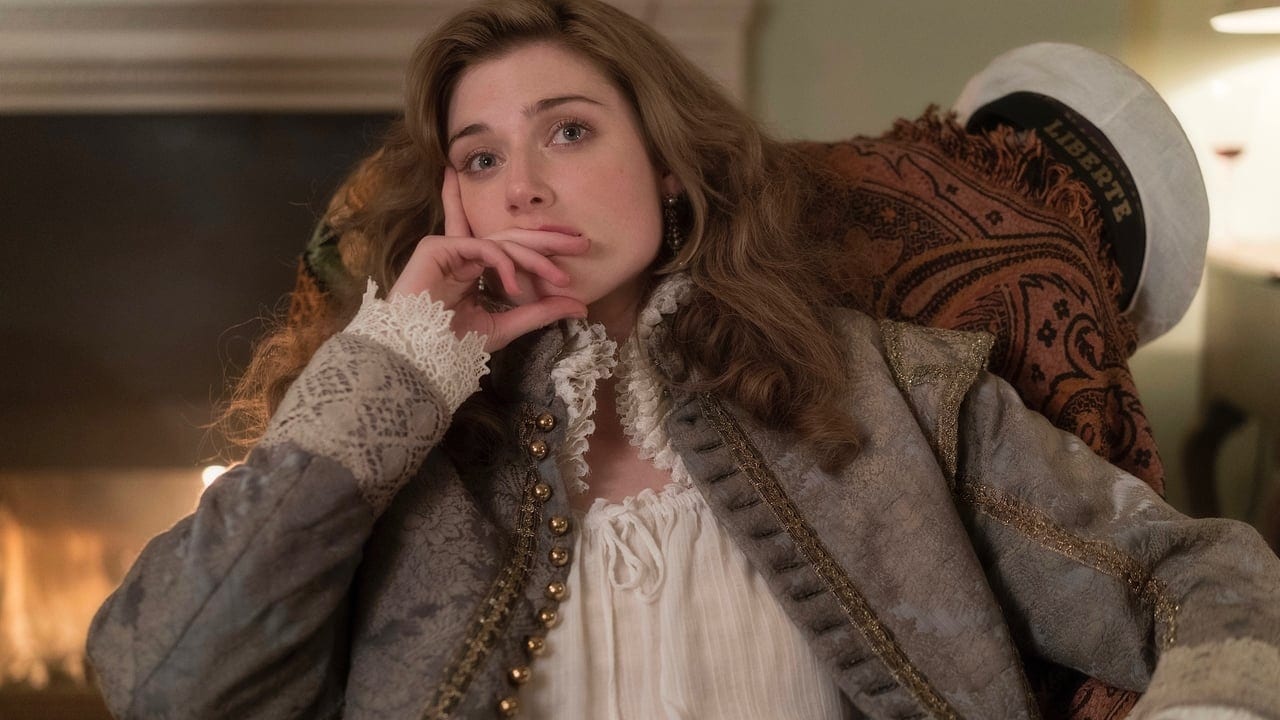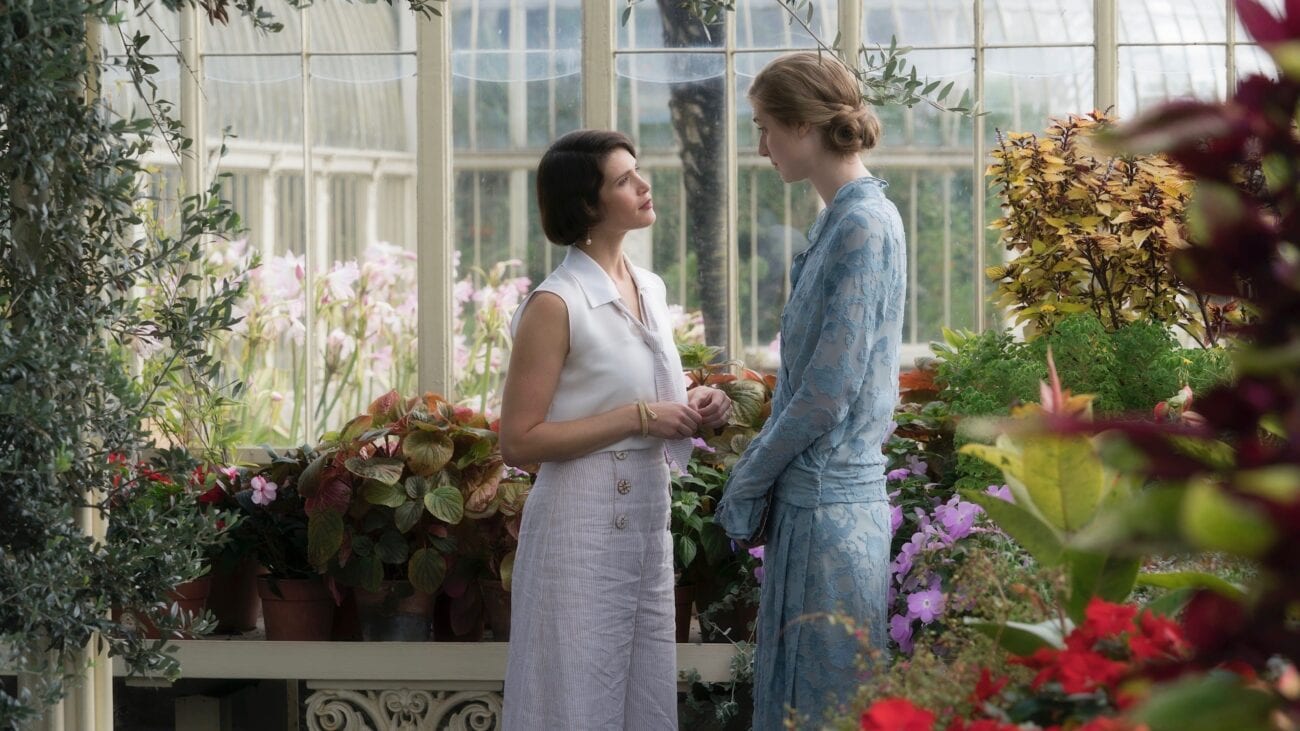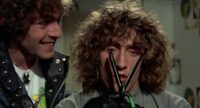Vita and Virginia (2019) explores the unofficial Bloomsbury Group—comprised of Virginia Woolf (Elizabeth Debicki), and her closest allies, although exactly who is still debated—as well as the affair between Woolf and Vita Sackville-West (Gemma Arterton). The Bloomsbury Group included Woolf’s husband, Leonard (Peter Ferdinando), and other notable literary figures of the time. This film takes us through Virginia’s first meeting with Vita, and their lives thereafter.
Woolf’s biggest legacy, aside from her writing, is Hogarth Printing Press. Founded by herself and her husband in 1917, Hogarth is named after their house in Richmond. In Vita and Virginia, we see inside this press, which makes for some beautifully atmospheric shots.

The novel most explored in this film was Orlando. Virginia Woolf wrote Orlando based on Vita Sackville-West, and how this came about is demonstrated to us. We are privy to conversations between the two, of Virginia suggesting to Vita that through Orlando they can truly get to understand one another, and of her expressing her desire to write a book that is entirely about Vita. We also see the fallout of this when Vita’s family, and especially her mother, find out that Virginia’s book is about her.
Including Orlando, Woolf wrote eight novels, and many other non-fiction pieces and poems. Some of her first articles were published by The Guardian. Woolf had strong views in support of feminism, pacifism, and spoke out against colonialism. This was during the early 10th century when society pushed back against these things. However, her views about class and race iterated in her private writings (specifically, her diary entries from 1915) are now considered to be offensive because of her apparent belief in eugenics. Because of this, it is not possible to classify her as entirely progressive in her views—although she was progressive for her time.
A Room of One’s Own (first published in 1925), and Mrs. Dalloway (first published in 1929) are said to have been influenced by Woolf’s support of the eugenics movement. You can read more about literature inspired by the eugenics movement in Modernism and Eugenics by Donald Childs (2007), the first three chapters of which concern Virginia Woolf and her more problematic opinions.
While the film stays true to the factual elements of the groups’ life, this omission creates a slightly rosy approach to who Virginia Woolf was. While, no doubt, she was an incredible writer and a forward-thinking woman, she was not perfect. In seeking to represent her on-screen, the omission of some of her more challenging traits and opinions is interesting. Because the film left out any details of Woolf’s death, seemingly in order to honour her respectfully, the additional omission of her problematic views comes across as a slight attempt at airbrushing some of the grittier aspects of her as a human. This being said, some of these omissions may have been less stylistic and more to ensure the BBFC age 12 rating of the film, encouraging family-friendly themes against an educational backdrop.
It is well-documented that Woolf suffered a mental breakdown at an early age, after the death of her mother which occurred when she was 13. It is speculated that she struggled with anorexia, and she was suffering from bipolar disorder for the duration of her adult life, and first tried to commit suicide aged 22. This is shown in the movie, but mostly in subtle and artful ways. The times she is shown to deteriorate mentally are tactful and considered, without shying away from showing the diminished mental state she was in.

The intensity of these scenes bleeds out into the others. Because we are always waiting to see what Virginia will do next, there is a high tension that can be felt even in the lighter scenes. Whether this transcending mood was intentional or not, I found that it added much more depth and body to the film as a whole.
There are points in the film where we see things that are only visible from Virginia’s perspective—for example one scene in which rapidly growing vines and their shadows appear, but only to her. This either references the illicit drug use often attributed to Woolf, or the hallucinations she may have experienced as a result of her bipolar disorder. Either way, this demonstrates that the world Virginia saw had more embellishments than the world the rest of us can see.
Virginia is painted as a wise person, despite her childlike wonder, overly demanding expectations of others, and her inability to hold typical conversations. She is portrayed very much as a person who, despite great emotional depth, never learned how to navigate that depth without sinking into it.
While some of the story feels sensationalised for effect, this is usually successful in creating specific moods, rather than feeling over the top. I particularly enjoyed the scenes showing a cross on the door Woolf was tucked behind while she worked. While I couldn’t find out if this was something she actually did, I thought it was clever and really emphasised how serious she was about her work.
The style is done with all the glamour of The Great Gatsby, all the pain of Romeo and Juliet, and all the eloquence of Shakespearian soliloquy. Aside from the discussion about Virginia herself, the backgrounds and the costumes of this film are lavish and styled perfectly to the era. Vita, especially, wears an array of visually stunning outfits.

Described by the English Heritage Site as a woman who, “adopted masculine styles of dress that were subversive, exploratory and playful in a time when traditional gender roles were being challenged”, Vita Sackville-West and her wardrobe are done justice here. Not only are there exquisite fabrics, furs, and colours, but there are trousers, jackets, and boots. These things were not typical for women in the early 20th century, but they were things that Sackville-West enjoyed wearing.
Throughout, it is very easy to see that you are watching the relationship of a poet and writer play out. My favourite line of dialogue comes just over halfway through the film, when the affair has started to consume Vita and Virginia. Virginia tells Vita, in an emotional moment, “you have as much of me as I have to give”, when Vita is asking for something that resembles more of a real relationship. This line represents all that Virginia is—a strong character who will always prioritise herself, someone who recognises their own emotional distance—and it displays her stark and admirable honesty.
There is never any doubt of the intelligence or articulacy of either woman. In fact, the only person who doesn’t speak with eloquence and decorum is Clive Bell (Gethin Anthony), Virginia’s brother-in-law. He is much more plain, normal, and periphery than the girls. Although, of course, an art critic and a fellow intellectual, this really allows the women in the film to stand out and not be side-lined.
It is nice to see the Bloomsbury Group as a female-dominated sphere. Even now it is rare to have intellectual spaces headed by woman. This film was itself directed by a woman, Chanya Button, and I think this shows through some of the dialogue, which was co-written by Button and Eileen Atkins (who wrote the book upon which the script was based).

The accuracy to Virginia Woolf’s real lifestyle is difficult to determine. While we have letters and articles from the time to chronicle events that took place, we will never know some of the conversations that happened in private between the two women—and indeed between the Bloomsbury Group as a unit.
This being said, the dialogue and charisma of the characters is upheld throughout (all credit to Debicki and Arterton). We are given a very believable simulation of their lives, and feel privy to them in a way that commends Button and her choice of style. Although not strictly auto-biographical, the woven in elements of the groups life all feel like a realistic education on how their situations may have looked.
The film demonstrates many things, but nothing more so than that Virginia Woolf’s legacy is still strong. The success of Vita and Virginia cements her timeless legacy. Her influence continues inspiring aspiring authors, and, based on the critical and audience receptions of the film, her reverence still echoes.
The movie ends without showing us or even alluding to Woolf’s suicide. There is a scene in the latter half of the movie where she can be seen standing dejectedly near crashing water, but this is very subtle. There is an elegance to leaving this out that I admire. Much as Woolf, a poetic and somewhat dramatic being, might almost have enjoyed the idea of causing scandal and creating discussion, I think this was the right choice. The tone of the film is very sad, but paints Woolf vibrantly with all her quirks and idiosyncrasies. It would have felt wrong and unnecessary to end with her death, and instead we are encouraged to remember her life.
Aside from its subject matter, Vita and Virginia is very aesthetically accurate of the era, but with flourishes that are particularly pleasing. I am, of course, referring to the beautiful buildings and costumes. Although much of the movie was actually filmed in the United Kingdom as a whole—in particular Ireland—there is a backdrop of 20th century England looking its’ best. We get a good idea of what the landscapes surrounding Woolf would have looked like, and we stay true to her era.
The film was a success at portraying these two women as authentic, passionate, and talented; with not one of these taking away from any of the others. It is a beautiful film, and one that should see long-lasting success as more and more fans of Virginia Woolf discover it.
Overall, although skimming or excluding some of Woolf’s biggest controversies, Vita and Virginia is an artful and stylish vision of the two women’s lives. We are reminded what a bold, empowered woman Virginia Woolf herself was, and her memory lives on vividly through this depiction. Vita and Virginia is an excellent film for lovers of Virginia Woolf, the feminist movement, or English scenery. Button has done a wonderful job of telling the crucial parts of Woolf’s story in accessible, semi-educational ways.


